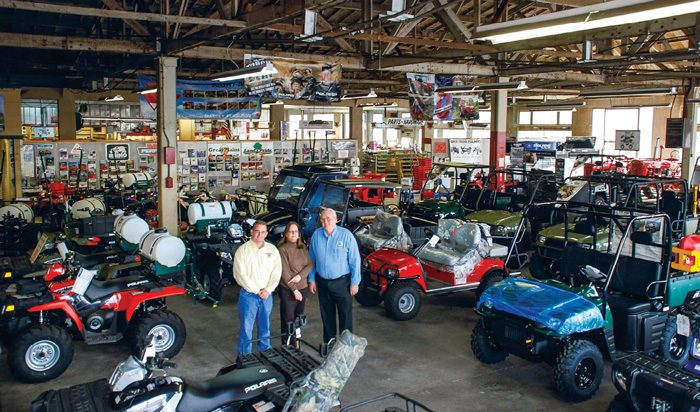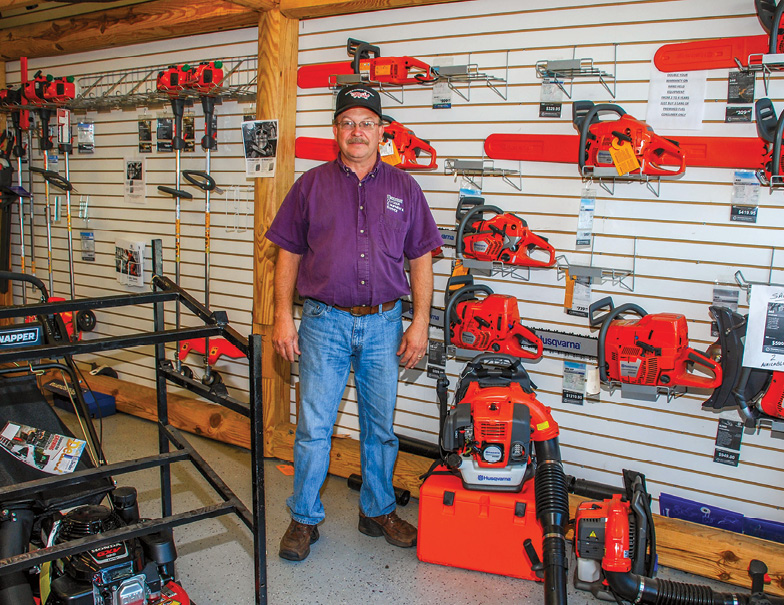Rural lifestyle customers expect to see an extensive inventory of rural equipment. Rick Gray, sales manager (left), Brenda Swartzbaugh, general manager, and Roger Gray, president (right), stand in the middle of an inventory display at Holt Ag Solutions of Modesto, Calif. (formerly Stanislaus Implement & Hardware).
The goal of Rural Lifestyle Dealer’s “How to Sell” articles over the years has been to disseminate sales practices to help you sell more. By sharing the wisdom of your peers, we hope to help you increase sales and profits from niche rural lifestyle equipment.
The series has featured products as diverse as wood burning stoves to post-hole diggers, and from tractor backhoe attachments to animal feed. Here’s a round-up of what we’ve learned since the series was first launched — a summary of advice from hundreds of dealers in various product categories. Some are focused toward specific products, while some apply to all items targeted at rural lifestyle customers.
Loving the Product
One common trait of anyone having success in a “niche” market is that they have a passion for it. It’s hard to hide non-verbal signs being passed on if the salesperson and/or owner aren’t totally sold on a product being offered. Customers can sense that lack of commitment to the product.
Sometimes, a passion can be kindled when the product becomes more familiar. Rick Gray of Stanislaus Implement & Hardware (now Holt Ag Solutions) in Modesto, Calif., shared his thoughts in the Spring 2008 issue about a salesperson who loved selling ag equipment, but had no desire to sell utility vehicles. Gray put him on the seat of a UTV and let him try it out. “He found that they were fun to use and before long he was having fun selling them. Today, he’s the most passionate person on the staff when it comes to UTVs.” He adds, “If your customer doesn’t see that excitement coming across, you won’t sell it … if you’re not passionate about it, you’re wasting your time.”
Roger Cann, owner of Canns-Bilco Outdoor Power Equipment in Alburtis, Pa., took the concept one step further when discussing chipper-shredder selling in our Fall 2014 issue. “Everyone from our receptionist to our mechanics to our brand new employees gets an opportunity to test our equipment. It’s especially fun for them to run the chippers and shredders,” says Cann. “Then, they’re more likely to tell everyone they run into, whether it’s a friend at the diner or someone calling on the phone. Our employees feel knowledgeable and excited and that increases job satisfaction and sales. Spouses and kids are also highly encouraged to come to demo days. We make it a family affair, so they’ll have more understanding when their spouse talks to them about what’s going on at work.”
|
|
| Carl Witte, owner of Maximum Outdoor Equipment & Service, Wichita, Kan., encourages customers to buy blowers with a mower purchase as an efficient way to keep machines clean after mowing. |
Stocking to Sell
Customers read your enthusiasm for the products you sell through your inventory as well as see all the options you offer. Over and over again, we hear dealers say that you can’t sell to rural lifestylers from an “empty basket.” Spencer Coleman of Coleman Tractor Co., with 2 locations in Paris and Clarksville, Tenn., reiterated that point in Spring of 2011, when he was sharing how to successfully sell rotary tillers. “The absolute biggest factor is stocking adequate inventory,” says Coleman. “They want a wide selection of implements that are in good shape and nicely displayed. You can’t drop them along the side of the building in the weeds or leave them in shipping crates behind the shop.”
Stocking high levels of inventory seems especially important for power sports products. “Nothing says you’re successful in this business like having a lot of inventory,” says Jeff Hollingsworth in our Spring 2008 issue. Hollingsworth is Hendershot Equipment’s asset manager and is responsible for UTV sales. Hendershot has locations in Decatur and Stephenville, Texas. “Having a good selection of the various models is eye-catching when people drop by. We carry 50-60 Polaris Rangers and ATVs.”
Promoting the Experience
A dealership’s appearance and atmosphere plays a major role in selling to lifestyle customers and is as important as any point-of-purchase technique. “We go to the extent of popping fresh popcorn at least 5 times a day and we always have fresh coffee brewing. It’s free to anyone who comes in. They come in, smell the popcorn, grab some and the next thing you know, they’re wandering around the store and asking questions. They sit on the equipment and talk to a knowledgeable salesperson. We want them to be comfortable being here,” says Gray of Holt Ag Solutions.
Zach Jensen, sales manager at WCT Outdoors of Brenham, Texas — a division of Washington County Tractor — told us in our Fall 2009 issue that their facility helps increase their success in selling ATV and UTV implements. Their dealership provides a lot of open space and features a large showroom and service building, plus 10 acres of land next door for equipment demonstrations. “The 15,000-square-foot showroom is set up to display equipment in mock environments, which include dirt, boulder and water scenery, to help customers imagine where the equipment might be put to use.”
Selling Knowledge
Dealer TakeawaysCustomers can read a dealership’s enthusiasm for products in niche markets. Volume will grow if the sales personnel have a passion for the products. Rural lifestyle customers expect a large selection of inventory and prefer it to be displayed out of the elements. They are more eager when they can try it before buying, either through rental or demo. Offering great service support helps sell anything at the dealership, but is especially critical with the lower profile products that customers may not know much about. Extra volume can be obtained by “upselling” at the time of purchase, especially if additional products can be included as part of a payment plan. |
In many of the rural lifestyle product categories, education plays a major role. Some novice rural lifestyle customers require extensive training about tractors and an even higher percentage need to be educated about attachments.
Mike Cooper, store manager at Race Brothers Farm Supply in Springfield, Mo., sells sprayers with his knowledge, “What separates us from the pack is that we know how to calibrate and use them. We can modify vehicles and mounts to the customer’s specific needs so they’ll get maximum flexibility out of what they buy here.” Cooper shared other attachment selling strategies in Spring 2010.
The same advice goes for outdoor power equipment. Jake Longnecker of Sumner Lawn ’n Saw in Puyallup, Wash., shared this strategy in Spring 2009: “Rural lifestyle customers are generally more task oriented than product oriented. They know what they have to do, but they don’t especially know what they need to do it with. They won’t always have an idea of the performance differences between product lines or models in a line. That’s where we come in as experts and offer knowledgeable advice on what they need for the job.”
Matt Linn, sales associate with Alexander Equipment in Lisle, Ill., says asking a lot of questions — and listening — helps sell wood splitters. He shared this advice in our Fall 2012 issue: “We want to find out the volume of wood that they are splitting, the size and type they are working with, what their budget range is, and what options, and styles of machines will fit them best.”

|
| Finding products that ease the seasonal ups and downs of the business has always been a challenge. Ferguson Lawn Equipment earns wood stoves sales by promoting its experienced installation team. The dealership is located in Traverse City, Mich. |
Many rural lifestyle products are sold after customers have had a chance to use the product, says Dave Heck of Jacobi Sales, with locations in southern Indiana and northern Kentucky. Heck shared his advice for skid steers in our Summer 2011 issue. “One of the ways we get customers interested in skid steers and attachments is through our rental services. That allows us to reach those consumers who might have a need for a skid steer for a few jobs. Once they try it out for a day or two and they see what else they can do with it, some will look for a rental-purchase option or buy it outright.”
Cory Forrester of Forrester Farm Equipment in Chambersburg, Pa., likes to demo backhoe attachments. Forrester told us this advice in our Fall 2007 issue: “For prospects that are first-time users, we take them to an area in back of our dealership and let them play with it. Make sure it’s an open area, though. If they’re sandwiched between two tractors, they’ll never do it. But, if they’re in a wide-open space with a little privacy, they’ll fall in love with it. Once the customer sees that it’s an easy-to-operate, left-to-right joystick controlled mechanism, much like a video game, he has to own one.”
Supporting the Product
At least once in almost every “How to Sell” article, dealers mention that you must support the product with service in order to sell it. Steve Meyer, of Midwest Equipment, Peoria, Ill., said in our Fall 2011 issue that it’s critical to offer preventive maintenance when selling generators. “Standby generators need someone to stop in once a year to change the oil and filter and simulate a power failure to ensure it works. For air-cooled generators, we charge a flat fee of $149 plus parts, which gets us out to a house once a year. We schedule those in October and November when we’re slow in the shop.”
“Customers can sense a lack of commitment to a product…”
Sometimes a “package” deal can help the sales and service departments and give the customer peace of mind. Jill Meier, former service writer at PrairieLand Partners’ store in Marion, Kan., used the technique when selling tractors and mowers. Meier said in our Winter 2013 issue, “Selling service packages with the initial sale allows the customer to wrap the cost of the service in with the financing. Usually, this means two or three inspection services, and we typically limit it to the warranty period of the machine, so that we can take advantage of that window.”
Butch Richmond, owner of Lawn & Garden Center in Gulfport, Miss., told us in Summer 2014 that the serviceability of the product sells premium power washers. “Let the big box stores sell the small-end stuff. It’s not competition. It’s a stepping stone. People have an interest in pressure washers, buy one from there and then find out they’re not going to last. They’ll have it maybe 6 months to a year and then the repair costs are more than it’s worth. They’ll come to us looking for expertise.”
Donny Sanders, president of Martin Truck and Tractor, in Columbus, Miss., now H&R Agri-Power, has found that promoting winter service differently increases business. He said in our Winter 2013 issue, “We think of winter service as the end-of-the-season service, where customers have their equipment checked before they put it away. But, through the years we’ve learned that the lifestyle customer doesn’t typically respond to fall or winter promotions. They get done cutting the grass in the fall, put the lawn mower in the shed and that is it until the spring. We have found they respond quite well to the pre-season specials that we run.”
Practice Upselling
Many products that we’ve profiled in “How to Sell” lend themselves to the art of upselling, or adding additional components to increase volume. They can be the main unit that opens a door to selling additional products, as in our “How To Sell Skid Loaders” article, or they can be the products you push after someone has decided on a power unit, such as in the “How to Sell ATV and UTV Implements” story. Dealers have shared some unique methods of upselling that help move more products.
“I always recommend blowers with mowers. Lawn mowers and water don’t mix,” says Carl Witte, owner of Maximum Outdoor Equipment in Wichita, Kan., referring to an owner using a hose to clean a mower after use. He said in our Fall 2013 issue, “People don’t always get a blower right away. They usually take some time to think about it. But once they get that mower home and it comes time to clean up afterward, they often come back in to get one.”
Upselling is especially critical with power sports because of the slim margins on ATVs and UTVs. Generally, you won’t make much money unless you add accessories. Gray of Holt Ag Solutions told us in Spring 2008, “You usually do best with couples. The husband doesn’t really care, because he’s thinking he’ll be putting the dog in it, go out in the field and tear it up. The wife wants the finer things in life and she’ll pick out a cab and a brush guard. And when it comes to accessories, there are literally dozens of choices, front and rear bumpers, brush guards, hard and soft-top cabs and roofs, cast aluminum rims, chainsaw holders and on and on. On an $11,000 vehicle, I’ve seen people spend $20,000 before they leave,” says Gray, pointing out that it’s not unheard of for customers to spend more on accessories than they do on the basic UTV.
An easy way to add volume on financed items is to equate the cost to a monthly payment. Cory Forrester of Forrester Farm Equipment uses this tactic to increase sales of backhoes. “During the sales process on a compact tractor, I’ll outline what the customer’s monthly payment would be, with and without the backhoe,” he said in our Fall 2007 issue. “At that time, the difference seems negligible to most.”
Evening Out Seasonality
Not every article has been about products that were “home runs” for dealers. For instance, many dealers continue to search for products that sell well in the off season. Some dealers are fortunate enough to participate in the snowmobile market, but sales can still be slow in some seasons. In some areas, the market doesn’t exist.
One strategy to consider is selling animal feed. David Record, general manager of Coufal-Prater in Navasota, Texas, shared in Summer of 2012 that their intention was to balance out revenue throughout the year. “We were hoping that the feed section would be busy at the time of the year that the equipment side was slowing down a little bit. To some extent that is true, but it’s not as clearly defined as we had predicted. They overlap much more than we thought they would.”
While integrating feed and equipment looked good on paper, neither of the dealerships interviewed in the story are still selling feed.
Looking Ahead
In the coming decade, we’ll continue to scan the horizon for the next great products that might appeal to new customers and help you expand your sales and profits. We’ll likely revisit some product categories to learn new twists on sales techniques.
If you have ideas about product segments or if you’ve stumbled on a “niche” product that is making money beyond your wildest dreams and you want to share the good news, leave a comment below.
Covering Niche MarketsHere’s a list of the niche product categories covered since the magazine launched in 2007. The variety of categories shows the diversity and strength of the market. |
|
| Backhoes | Fall 2007 |
| Utility Vehicles | Spring 2008 |
| Food Plot Equipment | Fall 2008 |
| Outdoor Power Equipment | Spring 2009 |
| Selling to Municipalities | Summer 2009 |
| ATV and UTV Implements | Fall 2009 |
| Small Sprayers | Spring 2010 |
| Wood Burning Stoves | Fall 2010 |
| Rotary Tillers | Spring 2011 |
| Skid Steers & Attachments | Summer 2011 |
| Generators | Fall 2011 |
| Trailers | Spring 2012 |
| Feed | Summer 2012 |
| Log Splitters | Fall 2012 |
| Off-Season Service | Winter 2013 |
| Post-Hole Diggers | Spring 2013 |
| Fencing | Summer 2013 |
| Blowers | Fall 2013 |
| Rotary Cutter | Winter 2014 |
| Seeders & Planters | Spring 2014 |
| Pressure Washers | Summer 2014 |
| Chippers/Shredders | Fall 2014 |
| Wood Stoves | Winter 2015 |
| Skid Steers | Spring 2015 |
| Chainsaws | Summer 2015 |
| Sprayers | Fall 2015 |







Post a comment
Report Abusive Comment